Japan
Wood Products Prices
Dollar Exchange Rates of 25th
May
2025
Japan Yen 142.85
Reports From Japan
Economy contracted faster than forecast
New economic data shows stagnant consumption and a
decline in exports. Japan's economy contracted at a faster
pace than expected in the first quarter of 2025 according to
date from the Cabinet Office. GDP contracted by 0.2%
compared to the previous quarter, the first quarterly drop
since the January-March period in 2024. However,
compared with the same quarter in the previous year, the
economy shrank by 0.7%, much steeper than the forecast
0.2% contraction.
The decline was largely due to a fall in exports which are a
significant driver of the Japanese economy. Data shows
international demand was waning even before US tariff
threats. On 2 April the US declared a 24% tariff on
Japanese goods. It also declared an additional 25% levy on
cars. The US is the largest market for Japan's auto
industry.
The Japanese government is negotiating a trade deal with
the US but policymakers are reportedly frustrated as the
US statements and proposals keep changing. Analysts
point out that the Japanese economy has been vulnerable
for some time as an aging population is driving up welfare
spending and there is a growing labour shortage.
Reuters news agency has reported a senior economist at a
major research institute saying “Japan's economy lacks a
driver of growth given weakness in exports and
consumption. It's very vulnerable to shocks such as one
from US tariffs". He added "the possibility of the economy
entering a recession cannot be ruled out."
See: https://www.dw.com/en/japans-economy-shrinks-more-
than-expected/a-72561544
Wage growth not keeping up with price increases
The Chief Economist at Mizuho Research and
Technologies is quoted by the Japan Times as saying
inflation in Japan might be tougher to tame than expected,
putting real wage growth at risk and possibly becoming a
drag on much-needed household consumption.
He added, “Japan struggled with deflation for decades and
kept interest rates at or near zero for years to get prices
rising again. They are now increasing and are becoming an
issue for workers who are finding their wages barely
growing or actually declining month to month on a real
basis”.
See:
https://www.japantimes.co.jp/business/2025/02/07/economy/japa
n-inflation-risk/
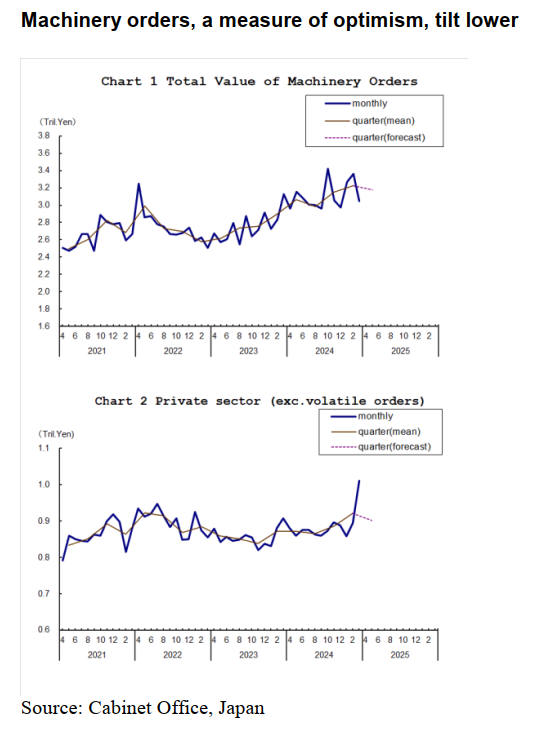
The total value of machinery orders received by 280
manufacturers operating in Japan decreased by 9.4% in
March from the previous month on a seasonally adjusted
basis. Machinery orders are an indicator of businesses
sentiment. In the first quarter 2025 orders increased by
2.4% compared with the previous quarter.
Private-sector machinery orders, excluding volatile ones
for ships and those from electric power companies,
increased a seasonally adjusted by 13% in March and rose
by 4% in the first quarter. In the April-June period the
total amount of machinery orders is expected to decline
and private-sector orders, excluding volatile ones, are also
expected to fall from the previous quarter respectively.
Non-manufacturers' sentiment remains positive
In the most recent Bank of Japan ‘Tankan Survey’ (April
2025) business sentiment among large Japanese
manufacturers weakened slightly. On the other hand, non-
manufacturers' sentiment remained positive primarily due
to robust inbound tourism and progress in passing on
rising costs. The manufacturing sector faces challenges.
Subsidies cut – household costs rise
Japan's core consumer prices in April climbed 3.5% year
on year, the fastest pace in more than two years. The rise
was driven by reduced government utility subsidies and
surging rice prices. The April increase in the core
consumer price index (which excludes volatile fresh food)
followed a 3.2 % rise in March and was the largest since
January 2023. Inflation has been well above the Bank of
Japan's 2% percent target since April 2022.
See:
https://mainichi.jp/english/articles/20250523/p2g/00m/0bu/0120
00c
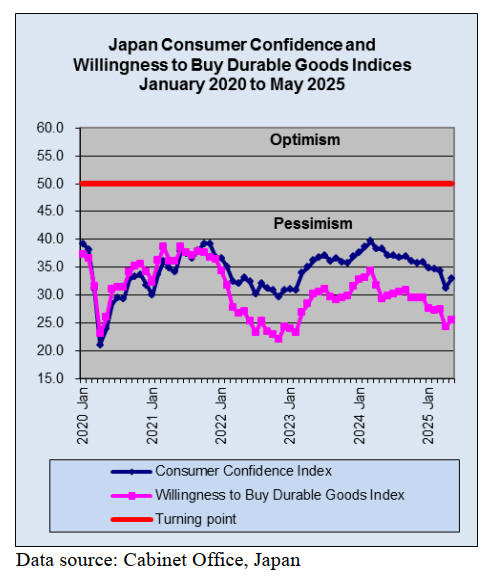
US and Japan agree - dollar-yen exchange rate reflects
fundamentals
The Japanese Minister of Finance, Katsunobu Kato and
US Treasury Secretary Scott Bessent, discussed currency
issues during the ongoing bilateral tariff negotiations with
both sides agreeing that the dollar-yen exchange rate, at
present, reflects economic fundamentals and the yen's
weakness against the dollar should no longer be an issue in
the tariff talks.
It has been reported that during the recent meeting Kato
said he expressed concern about the impact on the global
economy and financial markets of the uncertainty created
by the US administration's tariffs proposals saying using
tariffs to deal with trade imbalances is inappropriate.
See:
https://mainichi.jp/english/articles/20250522/p2g/00m/0bu/0070
00c

Rental homes becoming more expensive
In March every year many companies relocate there
workers and this period sees a surge in activity as both
companies and individuals prepare for these moves. This
practice is especially common among large corporations,
government departments and professionals in industries
such as finance, manufacturing and consulting.
Employees moving often receive assistance with
relocation costs but the high demand during this period
means moving services, rental prices and even temporary
accommodation options become more expensive and
difficult to book. For those relocating for work, early
planning is essential to avoid last-minute price surges and
limited housing options.
See: https://e-housing.jp/post/understanding-japans-moving-
season

Caution, the reason for the March surge has not yet
been
identified. A reporting error cannot be ruled out.
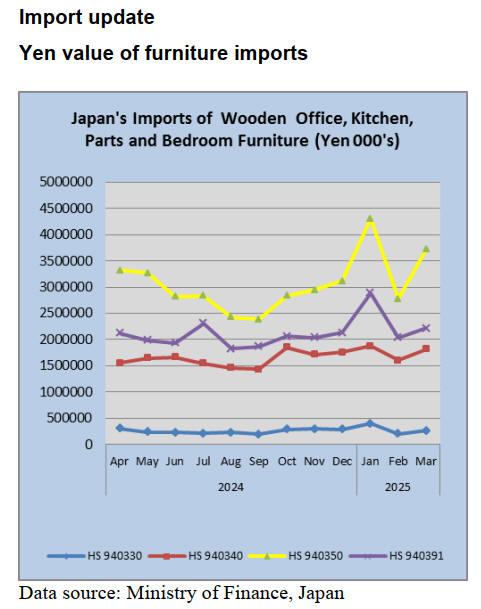
March wooden office furniture imports (HS
940330)
In March shippers in China accounted for 84% of Japan’s
imports of wooden office furniture (HS 940330), up 30%
on February. The other main source in March was Austria
which accounted for 6% of total HS 940330 imports, a
record high for Austria. The value of arrivals of wooden
office furniture from Malaysia in March were little
changed from the previous month while the value of
arrivals from Indonesia cashed 65%.
Year on year, the value of Japan’s imports of wooden
office furniture in March was little changed while,
compared to a month earlier ther was a 29% rise in the
value of imports.

March wooden kitchen furniture imports (HS
940340)
In March 2025 the combined value of shipments of
wooden kitchen furniture (HS 940340) from the
Philippines and Vietnam accounted for over 80% of
Japan’s imports of HS 940340. Shippers in the Philippines
accounted for around 51% of total imports of wooden
kitchen furniture in March with Viet Nam accounting for a
further 32%, up 43% from February.
T he other shippers of note in March were China and
Thailand which together accounted for around 11% of the
value of HS940340 imports. March arrivals from China
were almost 80% higher than in February and arrivals
from Thailand were up 45% month on month.
Compared to a year earlier the value of March 2025
imports was little changed year on year however, the value
of March imports was up 14% compared to February.
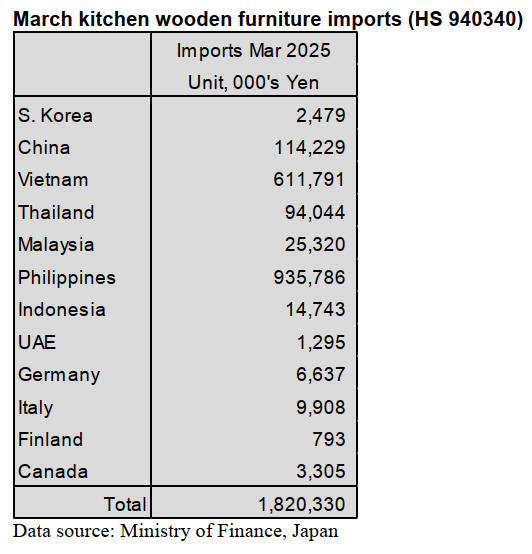
March wooden furniture parts imports (HS 940391)
Shippers in China, Indonesia and Viet Nam accounted for
most of Japan’s imports of wooden furniture parts (HS
940391) in March 2025. Of the total value of HS 940391
imports 48% was delivered from China (up 24% mom)
17% from Indonesia and; 11% from Viet Nam.
The value of imports of HS 940391 from Italy, a major
supplier in February, dropped 42% in March 2025
compared to a moth earlier.
The value of March 2025 imports was almost the same as
in March 2024 but compared to a month earlier March
2025 imports rose 9%.
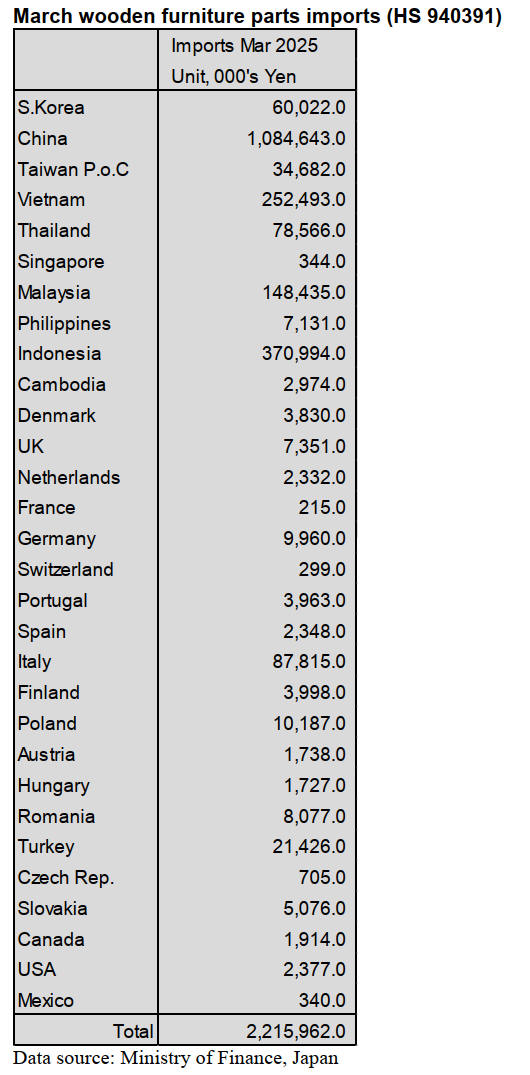
March wooden bedroom furniture imports (HS 940350)
The top two shippers of wooden bedroom furniture (HS
940350) to Japan in March 2025 were China (54%) and
Vietnam (39%). Malaysia was the other shippers of note in
March securing a 4% share of the value of imports.
March arrivals from China increased month on month by
40% with increase of over 40% from both Vietnam and
Malaysia.
Compared to March 2024 there was little change in the
value of imports in March 2025, however, there was a
major correction as March 2025 import values surged
compared to a month earlier bring the average import
value for February and March in line with the upward
trend seen in previous months.
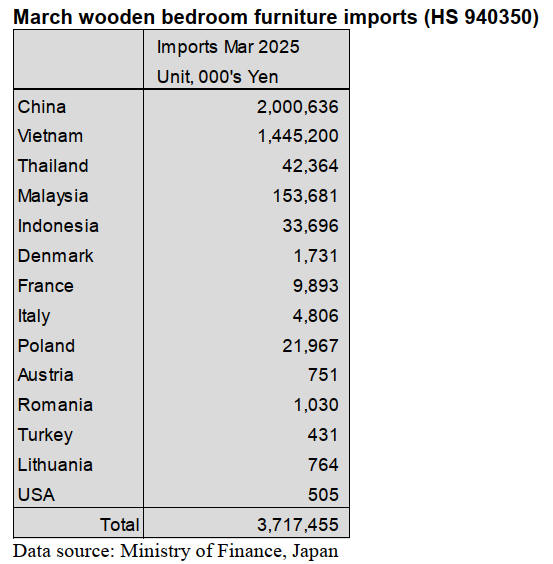
Trade news from the Japan Lumber Reports (JLR)
The Japan Lumber Reports (JLR), a subscription trade
journal published every two weeks in English, is
generously allowing the ITTO Tropical Timber Market
Report to reproduce news on the Japanese market
precisely as it appears in the JLR.
For the JLR report please see:
https://jfpj.jp/japan_lumber_reports/
Orders for house builders
The orders at many major housing companies and house
builders in March, 2025 exceed the orders of March, 2024.
One of reasons of exceeding the last year’s results is that
the price for per house is higher than last year. Also, the
companies ran promotions at the beginning of this year
and it appears that early sales activities, conducted with an
eye on the legal system reforms starting in April 2025,
may have contributed to securing orders.
The housing market is shrinking and it is difficult to
interpret the recovery of major companies' orders as a
market trend.
The orders for apartment buildings at some companies are
strong. Depending on the project, some negotiations that
were delayed from February to March due to winter
weather factors appear to have been finalized. As for
detached houses, market outlook differs between
companies.
Some companies have successfully driven sales through
proactive marketing efforts. The orders for renovations are
still firm. The application process for renovations of
existing homes under the Housing Energy Efficiency 2025
Campaign began on March 31, 2025. Moving forward,
renovation proposals utilizing subsidy programs are
expected to become increasingly active.
Cedar logs for China
The export price of Japanese cedar logs to China is
weakening. For Japanese cedar logs of 8 cm bigger, the
price is around $113, C&F per cbm, approximately $7
lower than at the end of last year. The background of
Trump administration in the U.S. imposing an additional
10% tariff on China on February 4 and another 10% on
March 4, caused a significant slowdown in purchasing
after the Lunar New Year.
Due to the ongoing appreciation of the yen, exporters have
fallen into unprofitability, and the export volume is highly
likely to shift towards a decline in the future.
The log price remains unchanged at around 12,000 yen,
delivered to export port per cbm. The freight rate for a
small vessel with a capacity of 2,800 cmbs is around
US$50,000 per ship. The price has fallen from the year-
end level of US$60,000, but with the yen appreciating
from around 153 yen per dollar at the end of the year to
approximately 143 yen per dollar, export costs remain just
underUS $120, leading to a deficit equal to the price
decline.
The port inventory of Japanese cedar logs at Taicang Port,
Jiangsu Province, China reportedly decreased from around
170,000 cbms in mid-March to below 140,000 cbms,
which is believed to have led to a decline in exports from
Japan.
1630,000 cbms of logs were exported to China from Japan
last year and it was 15.6 % more than 2023. The export
volume reached a record high. The export volume in
January to February, 2025 is 278,559 cbms and it is 35.8%
more than the same period last year.
Domestic lumber and logs
Domestic lumber continues to be in a tight supply-
demand balance. Kanto region, inventory of small sized
whitewood lumber at Tokyo port has been declining. Most
of studs braces have been purchased precutting plants. As
a result, prices have risen further enhancing the price
advantage of cedar. Inquiries to cedar studs are still strong.
The price of cedar stud for precutting plants is 60,000–
63,000 delivered per cbm. There is not enough cypress
lumber delivered from Kyusyu region to Kanto region.
The price of cypress sill for precutting plants is increasing
slightly. At the same time, demand for B-grade cedar
posts, foundation, and cedar studs with price advantages
has been increasing month by month. A-grade lumber
remains at high price levels as they need to align with the
lower price range of imported materials.
The price of cypress log in the northern part of Kanto
region and Chugoku region continued declining. Cedar
logs for a post is 13,600 yen, delivered per cm in the
northern part of Kanto region. This is 2,000 yen less than
last month. In Kyushu region, it costs 16,000 yen,
delivered per cbm and it costs 14,5000 yen, delivered per
cbm in Tohoku region.
Cypress log for a post in Chugoku region is 25,000 yen,
delivered per cbm and for a sill is 23,000 yen, delivered
per cbm. This is 1,000 – 2,000 yen more than the previous
month. Cypress log for a sill in the northern part of Kanto
regions is 24,000 yen and it is 23,800 yen in Shikoku
region. The price of a cypress log is 6,000 yen more than
last year. The price of a cedar log in the northern part of
Kanto region is around 1,000 yen less than last year.
Special feature
In 2024, the total value of U.S. lumber imports was
approximately 3.5 trillion yen, with 49% of the imports
coming from Canada. Following Canada, China accounted
for 8% of U.S. lumber imports in 2024, while Brazil,
Chile, and Vietnam each accounted for 7%. Japan's lumber
exports to the U.S. totaled 5.1 billion yen in 2024,
accounting for only 0.2% of total U.S. imports.
Additionally, a certain amount of processed wood
products destined for the U.S. are included in exports via
China.
The U.S. has designated certain exclusion items, including
pharmaceuticals, semiconductors, and timber such as logs,
lumber, plywood and wooden boards. For highly
processed wooden products like wooden fixtures, specific
exemptions apply, while other less-processed timber
products remain subject to the current tariff rates. Given
the relatively small trade volume, the direct impact on
forestry product transactions between Japan and the U.S.
is expected to be limited.
However, what kind of repercussions will Japan face due
to trade friction between the U.S. and Canada, and how
will the intensification of trade friction between the U.S.
and China impact the global economy? There are concerns
about how China's suspension of U.S. log imports, which
effectively serves as a retaliatory measure, will impact
major timber-producing countries such as New Zealand.
In 2024, the total U.S. trade deficit amounted to $1.2117
trillion, with China accounting for over 20%
(approximately US$245.4 billion). Mexico and Vietnam
followed as major contributors to the deficit."
In the timber and wood products sector, China imported
US$1.628 billion worth of goods from the U.S., while its
exports to the U.S. amounted to US$2.944 billion. As a
result, the U.S. recorded a trade deficit of US$1.316
billion. It cannot be simply determined from the data of
both countries, but the proportion of timber-related trade
in the U.S.-China trade deficit is only 0.5%.
However, on March 4, China announced a ban on
imported logs from the U.S., citing concerns over insect
damages. It is a retaliatory measure against the high tariffs
imposed by the United States.
The top imported timber in China consists of radiata pine
logs from New Zealand, which make up 49.6% of total log
imports, and sawn timber from Russia, accounting for
45.8% of total sawn timber imports.
Both categories together represent nearly half of China's
total timber imports. Imports from the United States rank
second for logs and fourth for sawn timber.
China has stopped importing logs from the United States,
leaving the key question of where to source alternative
timber. radiata pine from N Z and Australia, where
friendly relations have been restored, are viable
alternatives. It will be interesting to see how much Japan's
softwood log exports can grow in the timber import
market. China’s domestic timber demand, its role as an
export hub for the United States, and currency exchange
rate trends are all key factors to watch.
For China, securing hardwood is likely a bigger challenge
than sourcing softwood. China exports a range of wood-
based products to the United States, including furniture,
parquet flooring, fixtures, home equipment, and picture
frames. These wood-based exports make up 85% of the
total export value.
China has become one of the world's largest plywood
exporters. In 2024, China's plywood exports totaled cbms,
which is 2.8 times Japan's total domestic and imported
supply. China exported 308,000 cbms plywood to China
and this is 2.4 % of all plywood exports. China exported
plywood to the U.K. the most and it was 784,000 cbms but
it is still 6.1 % of all plywood exports.
Japanese logs
The impact of Trump-era tariffs on log exports primarily
affects local manufacturers in China who process Japanese
cedar logs and export them to the United States. Recent
log export performance remains strong, with total exports
in January–February 2025 reaching 302,000 cbms,
marking a 31% increase year-over-year.
Notably, 90% of these exports are destined for China.
However, some Chinese manufacturers have reportedly
put their orders for Japanese cedar logs on hold.
China's halt on log imports from the U.S. has heightened
expectations for NZ radiata pine, which remains a major
source of imported logs. As a result, Japanese cedar logs
have also seen increased interest from buyers looking for
alternative supplies.
The tariff on wood exports from China to the United
States has increased from 25% to 45% as of March.
However, cedar fencing materials have been granted an
exemption from reciprocal tariffs. Additionally, highly
processed wooden products such as wooden fixtures are
subject to reciprocal tariffs. If these wood exports from
China to the U.S. decline, there is a possibility that Japan's
log exports to China could also slow down.
|